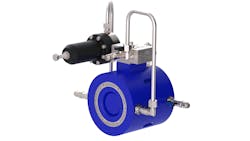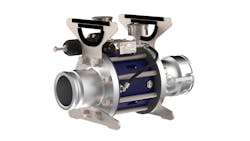Accurate pressure control delivers efficient service, maintains customer satisfaction
Providers of water management services strive to help businesses reduce costs and improve the efficiency of their water and wastewater infrastructures. However, their success depends on effectively tackling the challenge of water pressure regulation and head loss. All too often, this entails having heavy and cumbersome technology, which restricts the installation options and creates unwanted operational challenges.
Veolia was one company facing this very real problem. Its Mobile Water Services Division is a market leader in the provision of on-site purified water services from purpose-built tractor-trailers to industrial processors and plants across the United Kingdom and Europe.
In pressure management, too high an outlet pressure creates a huge risk of damaging expensive assets. However, insufficient outlet pressure could result in the failure to fully purify the system, which could reduce the quality of products or processes. Veolia recognized that accurate pressure control, from the hydrant supply through to the purification system and into the client’s system, was vital to delivering an efficient service and maintaining customer satisfaction.
“Our equipment needs to connect to many different customer utilities, which means lots of pressure differentials and varying flow rates. At the time, this was challenging to manage and posed a risk to both our and our clients’ equipment,” James Carr, European operations director of mobile water services at Veolia Mobile Water Services, said.
A Weighty Burden
Veolia had to regularly manage very large pressure drops, which meant having two pressure reducing valves (PRVs) to reduce the pressure over two stages. The problem was that the two separate products added up to more than 100 kg of equipment on their trailers, which reduced portability and increased the kerb weight of the trailers. Instead, it needed a provider to help it develop and deploy a more mobile and accurate solution for hydrant PRV assemblies.
The company turned to Oxford Flow, a manufacturer of innovative pressure control equipment, including the world’s first polymer PRV.
The PRVs came with integrated handles, supports, and quick-fit connections, meaning Veolia could easily install them. Often, companies rule out any kind of pressure regulation in hard-to-service infrastructures or — as in Veolia’s case — have managed with heavy duty setups. However, Oxford Flow’s flexible and simple design makes pressure regulation far more accessible and cost-effective.
More Streamlined, Better Performance
The rugged, lightweight design of Oxford Flow’s products allowed for easy adjustment of the set pressure as well as control of the speed of response. This made it much quicker and more efficient to set up and deliver precisely controlled pressure and flow exactly to the customer specifications.
Because weight was a big issue, Veolia had been looking at ways to reduce the size of its trailers. In particular, it wanted to fit more of its processing fluid onto the vehicles but without increasing the weight. A major advantage of Oxford Flow’s products was that Veolia was able to streamline its infrastructure from two PRVs weighing some 60 kilos each to just one PRV weighing around 25 kilos. As a result, it had a much more efficient solution that could reduce from a very high pressure in just one stage.
In addition to reducing the number of PRVs and overall weight, Veolia could increase its performance. Often, maintaining high performance at the lower end of the pressure spectrum can be a challenge. However, Oxford Flow was able to deliver market-leading head loss performance. “Because pressure can be controlled with such precision by these devices, there is reduced hunting. Flow turbulence and head drop are also minimized — and we’ve found it less noisy too,” Carr said.
Reducing costs was an important outcome for Veolia. One valve meant more maneuverability and potentially less labor to manage it. In addition, saving more than 50 percent of the weight of installation had major implications in terms of fuel consumption; with less to carry around, Veolia could reduce the overall carbon footprint of its trailer.
A Change of Tide
Ultimately, working with Oxford Flow has allowed Veolia to develop a more competitive water management offering. The PRVs are manufactured using the UK’s Water Regulations Advisory Scheme (WRAS)-approved acetal resin, making it considerably lighter — it can weigh as little as a tenth of that of the competitors’ PRVs. This massive reduction in weight has allowed Oxford Flow to permanently fit quick-release connections to the unit to enable rapid deployment on-site.
The real breakthrough was discovering that just one PRV could handle the pressure regulating flow rates that previously required two PRVs. This opened opportunities for new ways of working and could enable many more companies to access pressure regulation services for perhaps the first time. WW
About the Author
Neil Poxon
Neil Poxon is CEO at Oxford Flow. He brings almost 30 years of experience in the global oil and gas industry. In 2012, he became CEO of ProSep and in 2015, joined Peak Well Systems as global business development director. His appointment at Oxford Flow follows the acquisition of Peak Well by Schlumberger.

